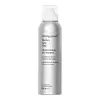What's inside
What's inside
 Key Ingredients
Key Ingredients

 Benefits
Benefits

 Concerns
Concerns

 Ingredients Side-by-side
Ingredients Side-by-side

Aloe Barbadensis Leaf Juice
Skin ConditioningWater
Skin ConditioningSodium Cocoyl Isethionate
CleansingSodium Lauroyl Methyl Isethionate
CleansingDistearyl Phthalic Acid Amide
EmollientSodium Lauroamphoacetate
CleansingGlyceryl Stearate Se
EmulsifyingGlycerin
HumectantSodium Methyl Cocoyl Taurate
CleansingPropanediol
SolventCocamidopropyl Betaine
CleansingSodium Methyl Oleoyl Taurate
CleansingCreatine
Skin ConditioningPanthenol
Skin ConditioningHydrolyzed Jojoba Protein
Skin ConditioningTocopherol
AntioxidantPersea Gratissima Oil
Skin ConditioningAdansonia Digitata Seed Oil
EmollientSimmondsia Chinensis Seed Oil
EmollientHydrolyzed Adansonia Digitata Seed Extract
Lavandula Angustifolia Flower/Leaf/Stem Extract
MaskingFoeniculum Vulgare Seed Extract
Skin ConditioningHelianthus Annuus Seed Extract
Skin ConditioningGuar Hydroxypropyltrimonium Chloride
Skin ConditioningDimethicone
EmollientLeuconostoc Ferment Filtrate
AntimicrobialCetrimonium Chloride
AntimicrobialPolyquaternium-7
Hydroxypropyl Methylcellulose
Emulsion StabilisingHydroxyacetophenone
AntioxidantBenzyl Alcohol
PerfumingPotassium Sorbate
PreservativeSodium Benzoate
MaskingCitric Acid
BufferingAloe Barbadensis Leaf Juice, Water, Sodium Cocoyl Isethionate, Sodium Lauroyl Methyl Isethionate, Distearyl Phthalic Acid Amide, Sodium Lauroamphoacetate, Glyceryl Stearate Se, Glycerin, Sodium Methyl Cocoyl Taurate, Propanediol, Cocamidopropyl Betaine, Sodium Methyl Oleoyl Taurate, Creatine, Panthenol, Hydrolyzed Jojoba Protein, Tocopherol, Persea Gratissima Oil, Adansonia Digitata Seed Oil, Simmondsia Chinensis Seed Oil, Hydrolyzed Adansonia Digitata Seed Extract, Lavandula Angustifolia Flower/Leaf/Stem Extract, Foeniculum Vulgare Seed Extract, Helianthus Annuus Seed Extract, Guar Hydroxypropyltrimonium Chloride, Dimethicone, Leuconostoc Ferment Filtrate, Cetrimonium Chloride, Polyquaternium-7, Hydroxypropyl Methylcellulose, Hydroxyacetophenone, Benzyl Alcohol, Potassium Sorbate, Sodium Benzoate, Citric Acid
Isobutane
Propane
Alcohol Denat.
AntimicrobialOryza Sativa Starch
AbsorbentCyclodextrin
AbsorbentZea Mays Starch
AbsorbentFurcellaria Lumbricalis Extract
Skin ConditioningHydrated Silica
AbrasiveHydroxypropyl Arginine Lauryl/Myristyl Ether Hcl
Skin ConditioningTetraselmis Suecica Extract
Skin ConditioningIsopropyl Lauroyl Sarcosinate
Skin ConditioningCetrimonium Chloride
AntimicrobialGlycerin
HumectantMannitol
HumectantPolyvinyl Alcohol
Disteardimonium Hectorite
StabilisingWater
Skin ConditioningParfum
MaskingCitronellyl Methylcrotonate
MaskingLinalool
PerfumingCitronellol
PerfumingBenzyl Salicylate
PerfumingCitral
PerfumingLimonene
PerfumingIsobutane, Propane, Alcohol Denat., Oryza Sativa Starch, Cyclodextrin, Zea Mays Starch, Furcellaria Lumbricalis Extract, Hydrated Silica, Hydroxypropyl Arginine Lauryl/Myristyl Ether Hcl, Tetraselmis Suecica Extract, Isopropyl Lauroyl Sarcosinate, Cetrimonium Chloride, Glycerin, Mannitol, Polyvinyl Alcohol, Disteardimonium Hectorite, Water, Parfum, Citronellyl Methylcrotonate, Linalool, Citronellol, Benzyl Salicylate, Citral, Limonene
 Reviews
Reviews

Ingredients Explained
These ingredients are found in both products.
Ingredients higher up in an ingredient list are typically present in a larger amount.
This ingredient is a preservative, antimicrobial, and emulsifier. It is often used in cosmetics for its ability to cleanse, condition, and reduce static.
Cetrimonium chloride is a quaternary ammonium salt, meaning it has a water-soluble structure.
Glycerin is already naturally found in your skin. It helps moisturize and protect your skin.
A study from 2016 found glycerin to be more effective as a humectant than AHAs and hyaluronic acid.
As a humectant, it helps the skin stay hydrated by pulling moisture to your skin. The low molecular weight of glycerin allows it to pull moisture into the deeper layers of your skin.
Hydrated skin improves your skin barrier; Your skin barrier helps protect against irritants and bacteria.
Glycerin has also been found to have antimicrobial and antiviral properties. Due to these properties, glycerin is often used in wound and burn treatments.
In cosmetics, glycerin is usually derived from plants such as soybean or palm. However, it can also be sourced from animals, such as tallow or animal fat.
This ingredient is organic, colorless, odorless, and non-toxic.
Glycerin is the name for this ingredient in American English. British English uses Glycerol/Glycerine.
Learn more about GlycerinWater. It's the most common cosmetic ingredient of all. You'll usually see it at the top of ingredient lists, meaning that it makes up the largest part of the product.
So why is it so popular? Water most often acts as a solvent - this means that it helps dissolve other ingredients into the formulation.
You'll also recognize water as that liquid we all need to stay alive. If you see this, drink a glass of water. Stay hydrated!
Learn more about Water